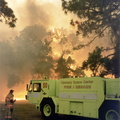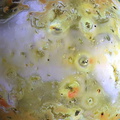
WIKIARCHIVES.SPACE
The Human Spaceflight Archive

This is the highest resolution color picture taken so far of Jupiter s volcanic moon Io by NASA s Galileo spacecraft. At 3 kilometers (about 2 miles) per picture element, the fiery satellite is seen against a backdrop of Jupiter's cloud tops, which appear blue in this false-color composite. Among the surprises seen on the moon s surface are several small, distinctly greenish patches and subtle violet hues at the cores and margins of bright sulfur dioxide-rich regions (like the one in the lower right). Dark spots, many flagged by bright red pyroclastic deposits, (deposits from explosive ejecta), mark the sites of current volcanic activity. Most of Io's riotous color is due to the presence of sulfur compounds, but the dark materials that make up the flows and calderas are probably silicate rock.
Information
- Taken in
- Author
- NASA/JPL/University of Arizona
- Description
-
This is the highest resolution color picture taken so far of Jupiter s volcanic moon Io by NASA s Galileo spacecraft. At 3 kilometers (about 2 miles) per picture element, the fiery satellite is seen against a backdrop of Jupiter's cloud tops, which appear blue in this false-color composite. Among the surprises seen on the moon s surface are several small, distinctly greenish patches and subtle violet hues at the cores and margins of bright sulfur dioxide-rich regions (like the one in the lower right). Dark spots, many flagged by bright red pyroclastic deposits, (deposits from explosive ejecta), mark the sites of current volcanic activity. Most of Io's riotous color is due to the presence of sulfur compounds, but the dark materials that make up the flows and calderas are probably silicate rock.
North is to the top of the picture. The images used to construct this composite were taken in the 1- micron, green and violet filters of the solid state imaging camera system on NASA's Galileo spacecraft. The images were taken on March 29, 1998 at a range of 294,000 kilometers (about 183,000 miles).
The Jet Propulsion Laboratory, Pasadena, CA manages the Galileo mission for NASA's Office of Space Science, Washington, DC.
- Created on
- Thursday 2 July 1998
- Albums
- US SPACE PROGRAM / PROBES / JUPITER / GALILEO / Mission Photos (Edited) / JUPITER / IO
- Source link
- https://photojournal.jpl.nasa.gov
- Visits
- 13
- Rating score
- no rate
- Rate this photo
- License
- Public Domain
- Modified by WikiArchives
- No (original)
- Downloads
- 0
Powered by Piwigo


